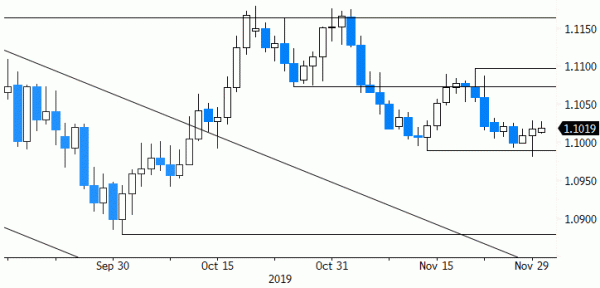- Rates: SPD leadership contest adds probability of upped German fiscal spending
Leftist candidates won the SPD leadership ballot, significantly raising the probability of upped German fiscal spending and of an end to the “grand coalition”. Core bonds sell-off this morning in a reflationary trade. The US manufacturing ISM is forecast to rebound further in November, but remaining below the 50 boom-bust mark. - Currencies: EUR/USD looking for a bottom near 1.10
EUR/USD extensively tested the key support just below 1.10 last Friday, but no sustained break occurred. The debate on more fiscal spending in Germany in theory could be euro supportive, but it remains a long call. The manufacturing ISM is expected to come off recent lows, but it might not be strong enough to inspire further USD gains.
The Sunrise Headlines
- WS dipped lower (up to -0.46%) over the weekend in a truncated US session. Asian markets are mostly ticking higher amid upbeat Chinese factory reports. Japan outperforms (+1%).
- The Chinese Caixin manufacturing PMI surprised on the upside in November. The PMI rose from 51.7 to 51.8 on the back of stronger employment whereas key components such as new orders and business sentiment remain sluggish.
- China is insisting the US to roll back tariffs as a top priority in any phase one trade deal, China’s Global Times reported. According to the sources, Beijing not only wants the US to slash planned tariffs, but curtail existing ones too.
- Iraq hinted OPEC and its allies are tossing around with the idea of deepening existing oils cuts by about 400K bpd. Oil prices rebounded by as much as 1.9% after Friday’s plunge following Saudi production comments.
- German chancellor Merkel’s government was thrown under the bus as SPD’s Norbert Walter-Borjans and Saskia Esken got elected on Saturday. The leftists have voiced opposition to the alliance with Merkel and demand a policy shift.
- Japanese firms raised capital spending by 7.1% (Y/Y) in Q3, widely beating the 5% forecast. Solid business investments provide a bright spot for the Japanese economy amid cloudy sentiment and murky demand.
- In today’s economic calendar manufacturing PMI’s in the US (ISM), UK and EMU (both final). ECB’s Lagarde testifies at the European Parliament, where her strategic review of the ECB’s mission is likely to play a prominent role.
Currencies: EUR/USD Looking For A Bottom Near 1.10
EUR/USD still looking for a bottom near 1.10
On Friday, trading in the major USD cross rates was mainly sentiment driven and technical in nature. There were no US data. EMU data (German labour data and EMU CPI) printed better than expected but had again hardly any impact on EUR/USD. The pair even extensively tested the 1.0989 support, but a sustained break didn’t occur. Later, a risk-off (end of month?) profit-taking also hurt the dollar. EUR/USD returned north of 1.10 (close 1.1018). USD/JPY closed at 109.62. This morning, Asian equities are starting the month on a positive tone. The China Caixin manufacturing PMI (51.8) was better than expected, indicating a further bottoming might be developing. USD/JPY rallied after the release but struggles to maintain early gains. The yuan is little changed near USD/CNY 7.03. In Germany, Chancellor Merkel’s coalition party, the SPD, voted for a left-wing leadership which might question the balanced budget approach. The bund future declines (higher yield) but for now with little impact on EUR/USD (1.1015 area).
Today, the calendar contains the final EMU November PMI’s and the US manufacturing ISM. For the ISM, a rise from 48.3 to 49.5 is expected. Comparable measures in other major economies (EMU, China) recently showed tentative signs of bottoming. The ISM might join this move, we doubt to already see a big upward surprise. The SPD leadership change will have no immediate impact on German government spending. Even so, we look out for the reaction of German yields. Anticipation on a potential future fiscal loosening might raise yields and in theory could be euro supportive. Admittedly it remains a (very) long call.
Last week, the euro stayed in the defensive, even as EMU data weren’t too bad. The 1.0989 support was extensively tested, but no sustained break occurred. Even so, the EUR/USD picture remains fragile. A drop below 1.0989/81 would bring the 1.0879 correction low in the radar. A return above 1.11 would call off the ST downward alert.
On Friday, EUR/GBP still held a tight sideways range in the lower half of the 0.85 big figure. The terrorist attack in London had little impact on trading. Some polls this weekend showed a slight decline in the lead of the conservative party. Sterling is losing a few ticks this morning. We expect sterling to stay strong as long as a Conservative majority remains to most likely scenario. Any comments from US president Trump (in London for the NATO summit) might cause some ST jitters.
EUR/USD holding near key support. Will debate on potential German fiscal stimulus support the single currency













